
Bodie is a ghost town in the Bodie Hills east of the Sierra Nevada mountain range in Mono County, California, United States. It is about 75 miles (121 km) southeast of Lake Tahoe, and 12 mi (19 km) east-southeast of Bridgeport, at an elevation of 8,379 feet (2554 m). Bodie became a boom town in 1876 after the discovery of a profitable line of gold; by 1879 it had a population of 7,000–10,000.

James Graham Fair was an Irish immigrant to the United States who became a highly successful mining engineer and businessman. His investments in silver mines in Nevada made him a millionaire, and he was one of the famous "silver kings" who became wealthy on the Comstock Lode. Fair later became a real estate investor and railroad builder in California. In 1881, he was elected a United States Senator from Nevada.
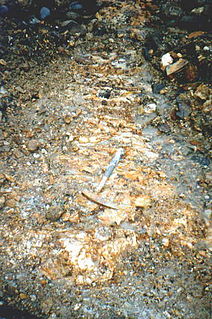
In geology, a lode is a deposit of metalliferous ore that fills or is embedded in a fissure in a rock formation or a vein of ore that is deposited or embedded between layers of rock. The current meaning dates from the 17th century, being an expansion of an earlier sense of a "channel, watercourse" in late Middle English, which in turn is from the 11th-century meaning of lode as a ‘course, way’.

Virginia City is a census-designated place (CDP) that is the county seat of Storey County, Nevada, and the largest community in the county. The city is a part of the Reno–Sparks Metropolitan Statistical Area.

The Comstock Lode is a lode of silver ore located under the eastern slope of Mount Davidson, a peak in the Virginia Range in Virginia City, Nevada, which was the first major discovery of silver ore in the United States and named after American miner Henry Comstock.

John William Mackay was an Irish-American industrialist. Mackay was one of the four Bonanza Kings, a partnership which capitalised on the wealth generated by the silver mines at the Comstock Lode. He also headed a telegraph business that laid transatlantic cables and he helped finance the New York, Texas and Mexican Railway Company.

John Percival Jones was an American politician who served for 30 years as a Republican United States Senator from Nevada. He made a fortune in silver mining and was a co-founder of the town of Santa Monica, California.

Silver City is a near ghost town and a small residential community in Lyon County, Nevada, USA, near the Lyon/Carson border. The population as of the 2000 census was 170.

Gold Hill is an unincorporated community in Storey County, Nevada, located just south and downhill of Virginia City. Incorporated December 17, 1862, in order to prevent its annexation by its larger neighbor, the town at one point was home to at least 8,000 residents. Prosperity was sustained for a period of 20 years between 1868 and 1888 by mining the Comstock Lode, a major deposit of gold and silver ore. Mines such as the Yellow Jacket, Crown Point, and Belcher brought in over $10 million each in dividends. Historical remnants of the town can still be seen, including the Gold Hill Hotel, promoted as Nevada's oldest hotel, in existence since 1861; the former Bank of California building; the restored Virginia & Truckee Railroad depot; the Depression-Era Crown Point Mill; and remains of several of the mines and residences in various states of restoration and repair.
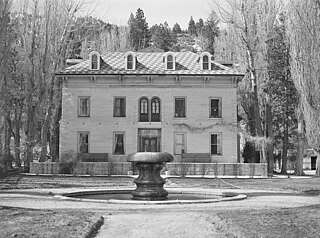
The Bowers Mansion, located between Reno and Carson City, Nevada, was built in 1863 by Lemuel "Sandy" Bowers and his wife, Eilley Orrum Bowers, and is a prime example of the homes built in Nevada by the new millionaires of the Comstock Lode mining boom.
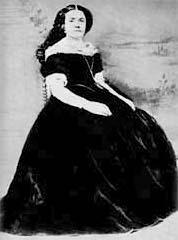
Alison "Eilley" Oram Bowers was a Scottish American woman who was, in her time, one of the richest women in the United States, and owner of the Bowers Mansion, one of the largest houses in the western United States. A farmer's daughter, Bowers married as a teenager, and her husband converted to Mormonism before the couple immigrated to the United States. After briefly living in Nauvoo, Illinois, she became an early Nevada pioneer, farmer and miner, and was made a millionaire by the Comstock Lode mining boom. Married and divorced two times, she married a third time and became a mother of three children but outlived them all.

James Clair Flood was an American businessman who made a fortune thanks to the Comstock Lode in Nevada. His mining operations are recounted to this day as an outstanding example of what may be done with a rich ore body and a genius for stock manipulation. Flood piled up millions as one of the famed "Bonanza Kings" and is considered to have been one of the 100 wealthiest Americans, leaving an enormous fortune. He is famous for two mansions, the James C. Flood Mansion at 1000 California St. in San Francisco, and Linden Towers located in Menlo Park, torn down in 1936.
Silver mining in Nevada, a state of the United States, began in 1858 with the discovery of the Comstock Lode, the first major silver-mining district in the United States. Nevada calls itself the "Silver State." Nevada is the nation's second-largest producer of silver, after Alaska. In 2014 Nevada produced 10.93 million troy ounces of silver, of which 6.74 million ounces were as a byproduct of the mining of gold. The largest byproducers were the Hycroft Mine, the Phoenix Mine, the Midas Mine and Round Mountain.
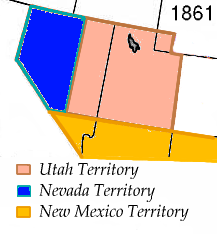
The History of Nevada as a state began when it became the 36th state on October 31, 1864, after telegraphing the Constitution of Nevada to the Congress days before the November 8 presidential election. Statehood was rushed to help ensure three electoral votes for Abraham Lincoln's reelection and add to the Republican congressional majorities.

Gold mining in Nevada, a state of the United States, is a major industry, and one of the largest sources of gold in the world. In 2018 Nevada produced 5,581,160 troy ounces, representing 78% of US gold and 5.0% of the world's production. Total gold production recorded from Nevada from 1835 to 2017 totals 205,931,000 troy ounces (6,405.2 t), worth US$322.6 billion at 2020 values. Much of Nevada's gold production comes from large open pit mining using heap leaching recovery.
Poeville, also known as Peavine until 1863, is the site of a historical mining town, established in 1864. John Poe, a professional promoter from Michigan allegedly related to Edgar Allan Poe, discovered rich gold and silver veins in 1862 on the slopes of Peavine Mountain. After the discovery of ore, Poe announced that the veins comprised the next Comstock Lode; he presented extracted ore at the state fair of 1864 as rich in content. As a result, the former mining camp, called Poe City (Poeville) or Podunk (Poedunk), grew to 200 people by 1864. Ore production in the mining district and population peaked around 1873-1874 with several hundred people living in town, supported by three hotels and a post office. The post office, named "Poeville", operated between September 1, 1874, and March 24, 1878.
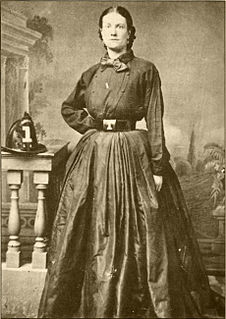
Julia Bulette, was an English-born American prostitute in Virginia City, Nevada, a boomtown serving the Comstock Lode silver mine. She was murdered in 1867, and French drifter John Millain was quickly convicted and hanged for the crime. Subsequent legends surrounding Julia's life and status as a sex worker and madam have grown over time and become a part of Virginia City folklore.

Eagle Valley is the area encompassing Carson City, Nevada. The valley was first settled during the California Gold Rush of 1849. The discovery of Nevada's Comstock Lode in 1859 established the economic importance of the area, which would become the site of the Nevada State Capitol.

Piper's Opera House is a historic performing arts venue in Virginia City, Storey County, Nevada in the United States. Piper's served as a training facility in 1897 for heavyweight boxing champion Gentleman Jim Corbett, in preparation for his title bout with Bob Fitzsimmons. The current structure was built by entrepreneur John Piper in 1885 to replace his 1878 opera house that had burned down. The 1878 venue, in turn, had been to replace Piper's 1863 venue which was destroyed by the 1875 Great Fire in Virginia City. Mark Twain spoke from the original Piper's stage in 1866, and again a century later in the third venue, as portrayed by Hal Holbrook in his one-man play Mark Twain Tonight! A lynch mob hung a victim from the first venue's rafters in 1871. American theatrical producer David Belasco was stage manager at the second opera house before moving to New York City. Piper's opera houses played host to Shakespearean thespians such as Edwin Booth. Musical performers Lilly Langtry, Al Jolson and John Philip Sousa once performed here. In 1940, Errol Flynn auctioned off historic Piper memorabilia from the opera house stage, during a live NBC broadcast that coincided with the premiere of Flynn's new movie Virginia City.
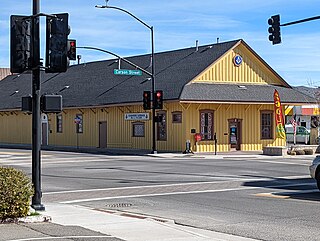
The Virginia & Truckee (V&T) Railroad Depot of Carson City, Nevada is a historic railroad station that is listed on the U.S. National Register of Historic Places (NRHP). It is significant for its association with the economically important role of the V&T railroad historically in Carson City following discovery of the Comstock Lode mine in 1859. To a lesser degree, according to its NRHP nomination, the depot building is also significant architecturally "as a well-preserved example of a wood-frame passenger depot procured from a railroad company pattern book within the V&T's former sphere of operation."


















